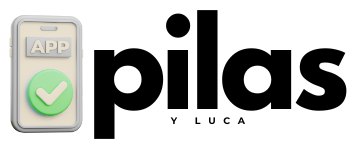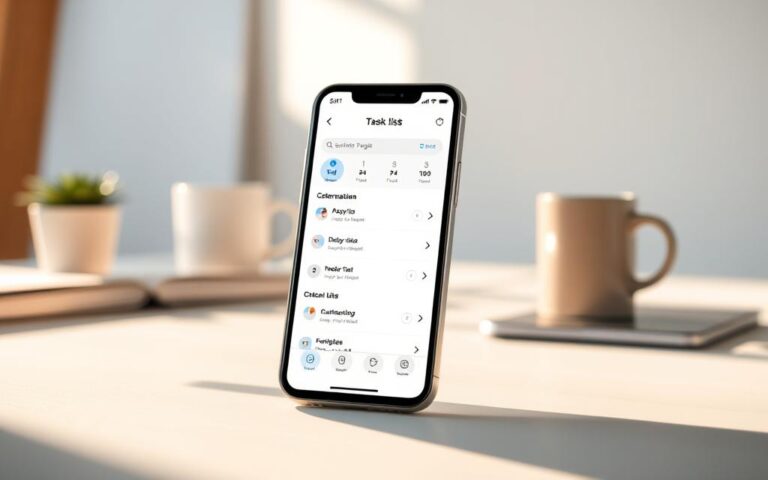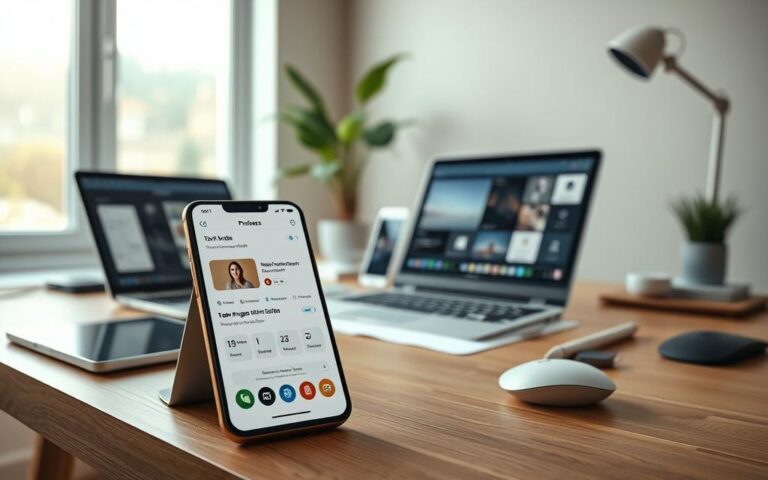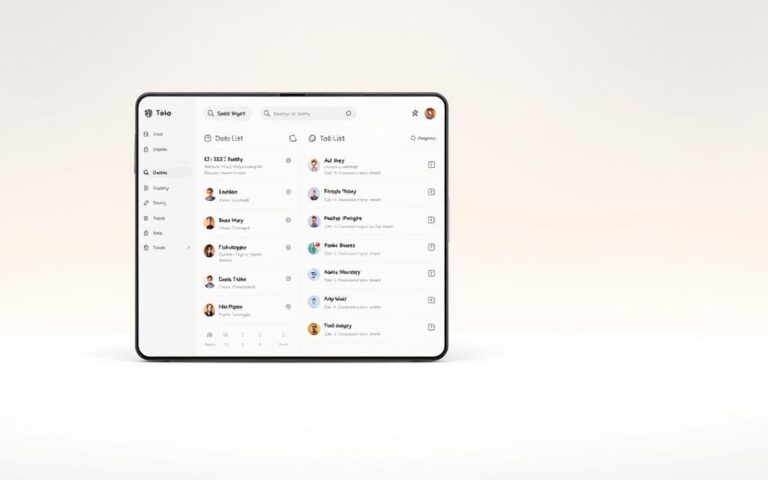Did you know only 18% of people use time management strategies daily? This shows how many struggle with planning and organizing. Luckily, daily organization apps are changing the game. They make life easier by organizing tasks and improving time management.
We’ll look at six amazing apps that can change the way you handle your day. You’ll stay organized and on track. We will check their features to find the best fit for you, making the most of your time.
The Importance of Daily Organization
Keeping your day organized is key to a balanced life and doing things efficiently. With daily planning tools, tasks become simpler and priorities are clearer. This can lead to less stress and a sharper focus. Many people find their workload overwhelming, but only about 13% feel they have it under control. By being more structured, you can beat this challenge.
Benefits of Staying Organized
Being organized has many upsides. Here are some of the main ones:
- Less stress and worry
- More focus on what’s important
- Better at making decisions
Good time management means facing daily challenges better. Daily planning tools help you see and sort your schedule well. This is the key to success.
How Organization Influences Productivity
Being organized boosts productivity. Arranging tasks well lets you focus on crucial ones. Managing time well increases what you get done. Let’s look at a few points:
| Aspect | Impact on Productivity |
|---|---|
| Clear Task Prioritization | Working on important tasks first gets them done faster. |
| Reduced Time Wastage | Less distractions means more productive work. |
| Better Work-Life Balance | Planning your day right gives you time for yourself. |

This approach to organizing your day keeps burnout at bay. It makes sure you stay productive with your tasks.
Overview of Daily Organization Apps
Daily organization apps are key for keeping track of tasks, deadlines, and schedules. They make it easier to handle the challenges of daily life. Users can choose the app that best fits their lifestyle and work habits.
What Are Daily Organization Apps?
These apps help people manage their time and tasks efficiently. They come with task management features like to-do lists and setting priorities. Features such as reminders and goals help users keep focused all day.
Key Features to Look For
When looking for a daily organization app, consider these features:
- User-Friendliness: An easy-to-use interface makes finding what you need simple.
- Customization Options: Being able to customize the app makes it work better for you.
- Integrations: Connecting with other apps, like Google Calendar or Slack, adds more value.
- Scheduling Tools: A good calendar helps you plan your tasks and meetings with ease.
App
Many apps offer different ways to keep everything in order. Understanding what each app does helps you make a good choice. We’ll review some apps soon, focusing on how easy they are to use, how well they work, and what they cost. This helps you choose the right tool for keeping organized.
Looking at these apps means checking out important things like how they feel to use and what they can do. By learning about what makes each app special and how much they cost, you can find the best one to help keep your days organized.
| App Name | Ease of Use | Effectiveness | Pricing |
|---|---|---|---|
| Todoist | Very User-Friendly | Highly Effective | Free / $3/month |
| Trello | Intuitive Interface | Effective for Teams | Free / $10/month |
| Microsoft To Do | Simple Layout | Very Effective | Free |
| Google Keep | Easy to Use | Efficient for Notes | Free |
| Notion | Customizable | Versatile | Free / $4/month |
| Any.do | User Friendly | Effective with Integration | Free / $3/month |
1: Todoist
Did you know that 70% of people feel overwhelmed by their daily tasks? This shows the urgent need we have for organization as life gets busier. Todoist steps in as a top task management app. It aims not just to simplify your tasks but to change how you work.
Todoist has a slick design and lets you easily make detailed task lists. You can also set deadlines and organize tasks into projects. Its Karma system is special because it rewards you for finishing tasks. This keeps you moving forward. The free version is good, but it limits how many projects you can have. Paying $4 a month for the Pro version gives you more features.
Read this review of Todoist to see how it can help sort out your day. It could take your productivity to the next level.
App
Todoist is a top tool for boosting productivity and organizing your day. It lets you keep track of tasks and projects with ease. Using Todoist daily can really step up your productivity game.
To get the most out of it, try these tips:
- Create Projects: Breaking down your goals into projects helps you stay focused.
- Set Priorities: Rank your tasks to focus on what’s most important first.
- Utilize Labels and Filters: Organize tasks by context or project for quick access.
- Daily Review: Take a few minutes daily to check your tasks and adjust plans as needed.
Following these steps can unleash Todoist’s full potential, improving your organization and boosting productivity.
2: Trello
Did you know that 94% of teams report improved work flow with visual tools? Trello leads in visual project management with its Kanban board feature. It lets people make boards for all sorts of projects. This helps see tasks clearly and keep track of them easily. Trello is great whether you’re working with others or on your own stuff.
Trello’s drag-and-drop makes moving tasks a breeze. Tasks move from “To Do” to “Done” smoothly. But, big projects might crowd Trello. This could make some think about getting Trello’s paid features for $5 per user a month for better flow.
App
Trello is great for organizing tasks visually. It lets users make boards for different projects, which helps keep things simple. Each board has lists and cards for tasks. This makes it easier for teams to handle big projects without getting mixed up.
It’s also awesome for working together. Team members can talk, share files, and give tasks to each other. Being able to see how the project is going makes everyone more responsible. It also helps everyone communicate better.
Using Trello well can make work flow smoothly. By putting tasks in lists, you can focus on each part while keeping track of the whole project.
Trello has cool features like deadline alerts, tools that work with other apps, and ways to make it your own. Teams can change Trello to meet their needs. This makes sure everyone knows what the project goals are.
| Feature | Description | Benefits |
|---|---|---|
| Visual Boards | Organized layout of tasks on boards. | Improves clarity in project tracking. |
| Collaboration Tools | Options for team communication. | Enhances teamwork and task transparency. |
| Task Assignments | Assign specific tasks to team members. | Encourages accountability and focus. |
| Integrations | Compatible with various productivity apps. | Seamless workflow management. |
Teams can handle complicated tasks with Trello, changing and updating as needed. This keeps the project moving forward.
3: Microsoft To Do
Did you know over 77% of people who set goals regularly reach them? Much of this achievement comes from being well-organized and good at managing tasks. Microsoft To Do helps by making it simple to schedule tasks across devices. It makes sure you can easily handle your daily duties. The app works smoothly with Microsoft 365, letting users make lists and set reminders. It also highlights task priority with the “My Day” feature.
This app is great for personal and work tasks. Microsoft To Do gives you the tools to be more productive. Thanks to its easy-to-use design and helpful features, this free app is a must-have for anyone wanting to better manage their time.
App
Microsoft To Do is great for keeping things organized, especially in business. It works well with other Microsoft apps. Users can easily sort and handle their tasks every day. The app is simple to use, with everything you need just a click away.
It helps make sure you don’t forget anything important. You can set reminders and due dates. This helps you plan your day better and keeps you on track.
Here’s a table showing why Microsoft To Do is better than old-school ways of staying organized:
| Feature | Microsoft To Do | Traditional Methods |
|---|---|---|
| Task Prioritization | Dynamic list, customizable priority levels | Manual ranking, often inconsistent |
| Reminder Tools | Automated reminders for tasks and deadlines | Post-it notes often overlooked |
| Integration | Syncs with Outlook and other Microsoft apps | Standalone use, limited interconnectivity |
| User Experience | User-friendly interface, quick navigation | Can be cluttered, difficult to follow |
The table shows how Microsoft To Do beats old ways of organizing tasks. It’s great for anyone, from personal use to business. It makes handling tasks easy and efficient.
4: Google Keep
Did you know that over 1.5 billion people use Google services around the world? Many of them use Google Keep for writing down notes and managing tasks daily. It’s made for those who like keeping things simple and fast when writing ideas or making lists. In our review of Google Keep, we’ll see how well it works with other Google services. This makes it perfect for users who want to share their notes and lists without any hassle.
Google Keep is known for its simple design and features like talking to write notes. It might not have everything needed for big project management, but it’s great for organizing everyday tasks. This makes it super helpful for anyone wanting to get more done each day.
App
Google Keep is a top choice for jotting down notes. It’s easy to use, helping you stay organized every day. With just a few clicks, you can make notes and lists quickly. It’s great for anyone who wants to keep things simple and efficient.
With its checklist feature, keeping track of tasks is a breeze. It lets you share lists with others, making teamwork easy in both your personal and work life. Plus, you can access your notes on any device, like your phone, tablet, or computer.
Google Keep does more than just reminders and notes. It lets you add photos and voice memos too. Its simple design makes staying productive and organized easy, cutting down the chaos in your life.
5: Notion
Over 20 million people worldwide use apps like Notion to make their work easier. This number shows how popular tools for organizing digitally have become. Today, we’ll see how Notion, a flexible planner, can change how you handle tasks every day.
Notion is known for letting users make pages that fit their needs, including tasks, notes, and databases. Its ability to change for each person is important. But, this flexibility means newcomers might find it a bit hard to learn. Notion’s subscriptions start at $10/month, which offers more features and teamwork options.
App
Notion is a great platform for different organizational tasks. It helps manage personal tasks, big projects, and learning materials well. Users can change their workspace to meet their needs.
This platform combines many project management tools in one place. It makes working together and keeping track of things easy. Notion is good for both students and professionals because it organizes materials well. As an educational app, it provides many templates and tools to improve learning.
6: Any.do
Did you know around 70% of people find organizing daily tasks hard? This shows how much we need efficient tools like Any.do. It’s a top app for daily planning. Any.do lets you combine your to-do lists and calendar events in one easy-to-use place.
This review of Any.do looks at its easy design and smart tips that make prioritizing tasks simple. With a free version and premium options starting at $2.99 per user each month, Any.do is great for anyone wanting to stay organized. It makes sure you don’t miss any tasks.
Comparing the Apps: Which Fits Your Needs?
Finding the right tools for daily planning means comparing different apps. You have to look at what each app offers. Things like how easy it is to use, the cost, and how it looks matter to different people. Learning from what other users say helps a lot when picking the best app.
Criteria for Selection
- Ease of Use: Simple and easy-to-understand apps are often the top picks.
- Features: You need to think about what features are must-haves. Maybe you need a to-do list or a way to keep track of appointments.
- Pricing: Some apps are free, but others might charge you. You have to decide based on your budget.
- Customer Support: Good support is key if you run into problems with the app.
User Reviews and Ratings
What people say about an app can really guide you. Reviews point out the good and the bad, helping you figure out which app is right for you. Looking at ratings can quickly show you if an app is worth trying. Hearing from others can lead you to an app that fits your organizing style perfectly.
Tips for Maximizing App Efficiency
To really make the most of daily organization apps, there are smart tips you can follow. Doing so boosts your productivity in meaningful ways. By using these tools often, you manage tasks well and become more effective.
Regular Updates and Reviews
Keeping your apps efficient means checking your tasks and updating your goals regularly. This habit helps you see what you’ve done and what’s next. When you use your apps a lot, you can tweak your plans as you reach your goals. This makes your daily organization tools very helpful.
Setting Realistic Goals
It’s important to have goals you can actually reach when you’re trying to be more productive. Break big tasks into smaller, doable steps. Pick the most important ones to do first. This keeps you from feeling overwhelmed and makes success clearer. Your daily app use becomes way better when you match it with goals you can hit.
Integrating Apps into Your Routine
Adding daily planning apps to your routine boosts productivity and helps form a solid planning habit. These apps make it simpler to handle tasks, meet deadlines, and keep track of reminders. They can completely change how you organize your tasks.
Building a Daily Organization Habit
To build a habit of daily organization, use your apps consistently each day. Pick a time every day for planning. This not only holds you accountable but lets you look back and plan ahead.
Features like calendars and reminders keep you focused on what’s important. They help cut down on missing important tasks.
Combining Multiple Apps
Using a mix of apps often works best. Different apps have special features that work well together. This makes you more effective.
For instance, linking a task manager with a calendar app makes your schedule smoother. Seeing all tasks and deadlines in one place keeps you productive and on track to hit your goals.
| App Name | Key Features | Integration Options |
|---|---|---|
| Todoist | Task prioritization, reminders | Google Calendar, Slack |
| Trello | Visual boards, checklist options | Google Drive, Evernote |
| Microsoft To Do | Task lists, deadlines, shared lists | Outlook, OneNote |
| Google Keep | Notes, reminders, voice memos | Google Drive |
| Notion | Database options, customizable templates | Slack, Google Calendar |
| Any.do | Task syncing, reminders | Gmail, Google Calendar |
Conclusion: Finding the Right App for You
Exploring daily organization apps reveals many strong tools. These can help users organize tasks better. Finding the right app is key to improving your productivity. It’s important to check out different apps and see which one fits your needs best.
Finding the best app can really change how you handle tasks at work and home. Each app has special features for different needs. So, take your time to try them out and find one that matches your way of organizing.
The main goal is to work more efficiently and have an easier day-to-day routine. Try out various apps and see how they fit into your life. You might find the perfect tools to boost your productivity.



